Armoring a warship doesn’t seem like it should be hard. Figure out how much armor you need to stop what you expect to be shooting at you, and then slap that much on.
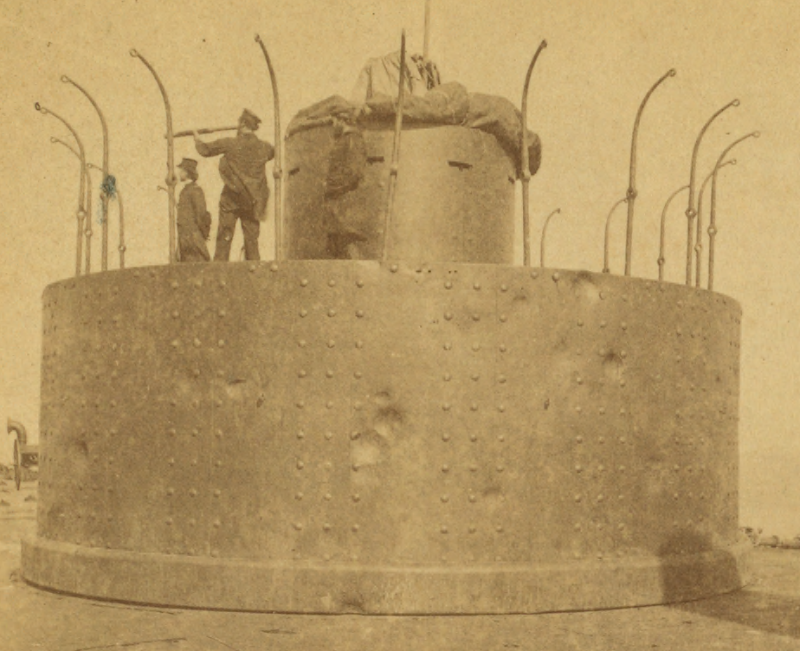
Dents on the turret of a Monitor after seeing action
In practice, it’s not that simple. Armor is heavy. Steel weighs 40 lbs per square foot per inch of thickness.1 Over an area the size of a battleship, that adds up very quickly. Except for a brief period at the very beginning of the armored warship’s history, it’s never been possible to armor an entire ship against an enemy’s main weapons at battle ranges, and even this was essentially an aberration caused because those weapons were optimized against unarmored ships. Designers thus began to concentrate armor in important areas. This was made somewhat easier by the growing power of weapons, which meant that the large number of broadside guns of the first ironclads were replaced by a much smaller number of weapons in a central battery, soon known as the citadel. This was armored, and a belt was retained to protect the full length of a ship’s waterline,2 and a thin armored deck on top to stop shells entering from above, and to keep splinters from shells hitting above the belt out of the citadel. Bulkheads at the ends of the citadel sealed it against fire from ahead and astern.
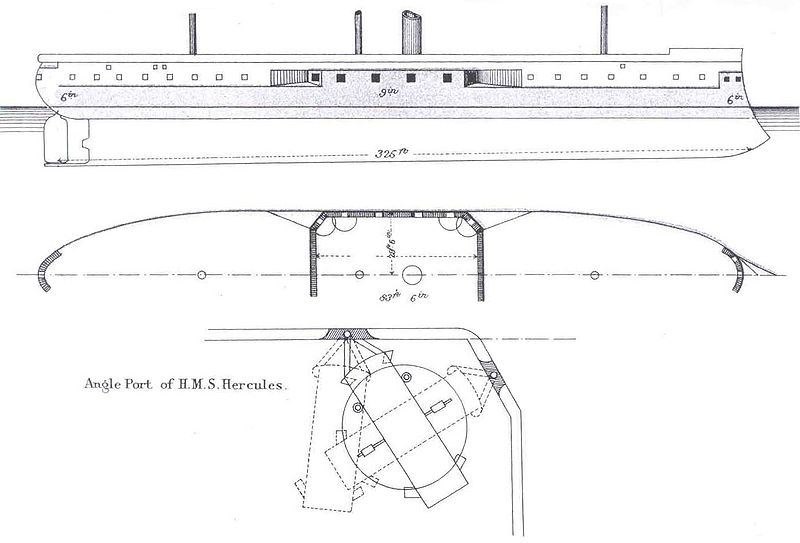
HMS Hercules, with central citadel and waterline belt
This basic pattern of a waterline belt, protective deck and central citadel continued to be the basis of capital ship armor throughout the life of the battleship, although several distinctive variants were used at different points. When turrets appeared, they were placed on top of the citadel, which was usually lowered to keep the guns at a similar height above water. In this era, low freeboard was sometimes considered desirable to reduce the target the enemy had to aim at, and the citadel also allowed ventilators and uptakes3 to be placed high enough in the ship to not be flooded in bad weather.

HMS Dreadnought, showing the later citadel layout.
In the mid-1870s, the Italians, followed by the British, adopted a slight modification. Instead of carrying the belt the full length of the hull, they limited it to the length of the citadel, and moved the armored deck slightly below the waterline at the ends. The spaces just above the deck were heavily subdivided and used for storage, making them harder to flood. This scheme protected the buoyancy of the ends, and care was taken to make sure that the ship would remain afloat and stable even if the ends were riddled.4 This armor layout can be thought of as prioritizing protection of stability, as opposed the the protection of mobility provided by the full-length belt. For a given ship, the protective deck is lighter than the full belt, but the ship's speed will suffer if the ends flood. The French never adopted the protective deck and short belt, as they were much more concerned about close-range melees and ramming.
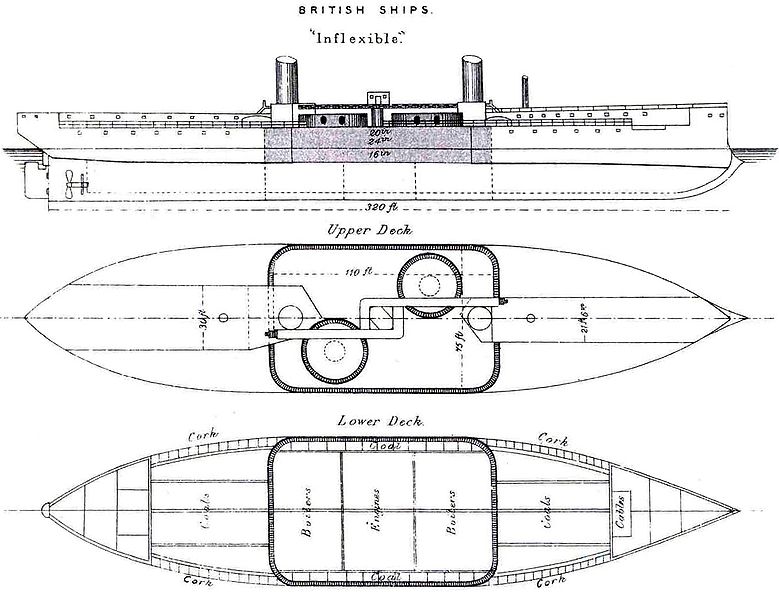
HMS Inflexible, illustrating the protective deck
An alternative to the turret was developed in the barbette, a term used to refer to any form of mounting where much of the protection for the gun was fixed instead of rotating, although some mounts had lightly-armored hoods. In most cases, this was an armored tub in which the gun sat, with a thin armored tube running down to the magazines below the armored deck. The problem with this was that in many cases the bottom of the barbette tub was not armored, so shells bursting below it could disable the guns. Even if there was armor, the foundations supporting the guns were still vulnerable to QF gunfire.5 The gun partially retracted into the tub to reload, giving the crew and loading mechanisms some protection. In theory, only the aimer had to come over the edge, and he was provided with an armored hood, although almost everyone except the British provided light (1-2") armored hoods for their barbettes. The major advantage was that the guns could be mounted higher than in turret ships.6 Later barbettes protected their foundations by running at full width down to the armored deck.
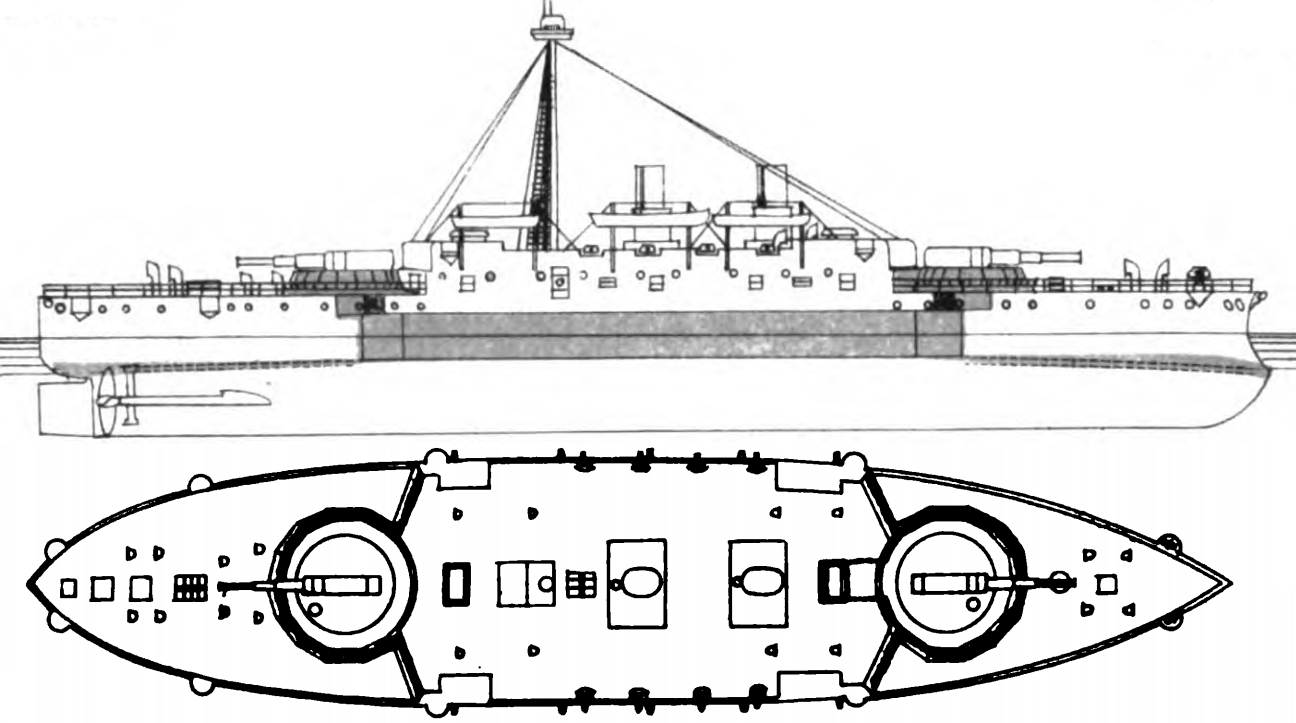
HMS Benbow with early barbettes
By the early 1880s, conditions had changed again. New technology allowed 6" Quick-Firing (QF) guns, which could tear up the parts of a ship unprotected by heavy armor. This made the open barbette untenable, and it soon merged with the turret as heavier and heavier hoods were placed on them.7 End belts, although of only a few inches, returned, and light upper belts were installed amidships to protect the supply arrangements to the quick-firing guns. The QF guns themselves were placed in casemates, gun positions with a medium-thickness front plate and lightly armored sides and rears. On most of the pre-dreadnoughts, the armor deck was fitted with sloped edges, meeting the lower edges of the belt, so that any shell had to pass through both the belt and the deck before it reached the vitals. This in turn allowed the belt to be much thinner, freeing weight for bigger areas of thin anti-QF armor.
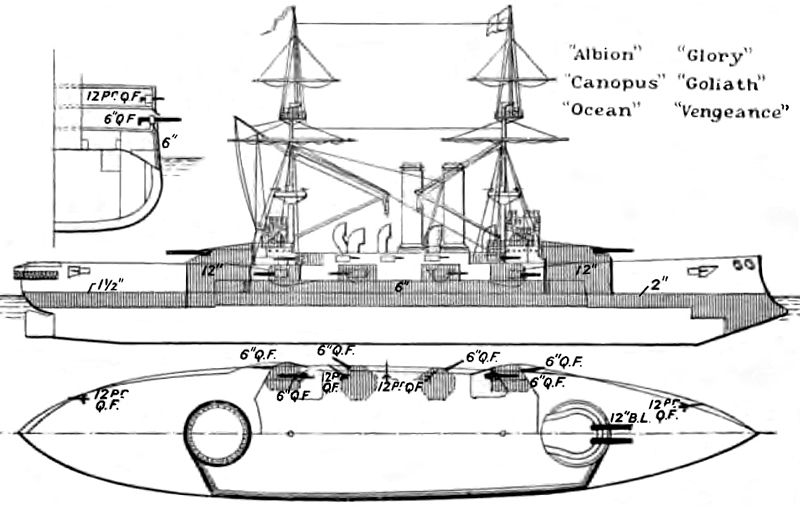
The classic pre-dreadnought layout on the Canopus class
From 1860 to about 1880, armor was simple wrought iron, with a thick wooden backing. This backing was intended to absorb shock and prevent the bolts holding the armor on from breaking when the plate was hit with a heavy round. As guns grew more powerful, plates increased in thickness, reaching 24" in some ships. In 1876, the first mild steel armor was produced by the French, and quickly superseded wrought iron. This armor was strong enough to shatter all projectiles, although the armor was often damaged in the process. The British, who could not match French steelmaking, used compound armor, essentially a mild steel faceplate welded to a backing of wrought iron. This was the first type of face-hardened armor, where different material properties are used in a plate to enhance its resistance to penetration. The hard steel face is used to damage the projectile, making it easier for the tough back to absorb the impact. Both types were approximately 25% more effective than wrought iron on its own.
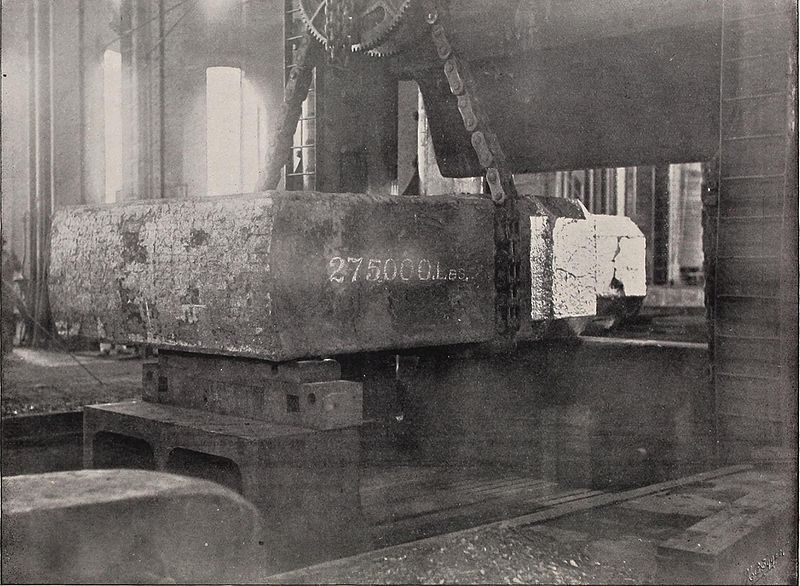
An armor ingot during the production process
However, this was an era of rapid advancement in metallurgy, and in 1889 nickel steel plates began replacing both mild steel and compound armor, giving another 5% improvement over those materials. The next year, an American, Hayward Harvey, figured out how to face-harden a nickel-steel plate, 'cementing' the surface of the plate by holding it at high temperatures in contact with charcoal for a week or two before cooling it quickly. This turned the face of the plate into very hard high-carbon steel, while the back remained tough. The plate would then be rolled down slightly, adding strength through cold-working. Harvey armor was 15-20% better than a similar thickness of nickel steel.
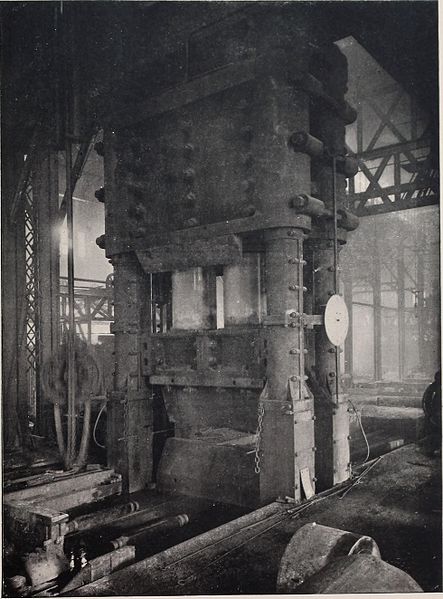
A heavy press for forging armor
Harvey armor was only the standard for about three years before the German Krupp company managed further improvements, producing Krupp armor.8 Krupp added chromium to the nickel steel, which not only improved metallurgical properties, but also allowed a new process called decremental hardening to be used. Decremental hardening involves heating up the front 30-40% of the plate, then cooling it rapidly. The heated face is much harder than the back, but also much deeper than the cemented face of Harvey armor.9 Early Krupp armor was 15% more effective than Harvey Armor, as the cemented face of Harvey Armor cracked at the first blow, while the decrementally hardened layer could continue to damage the shell during the initial penetration.
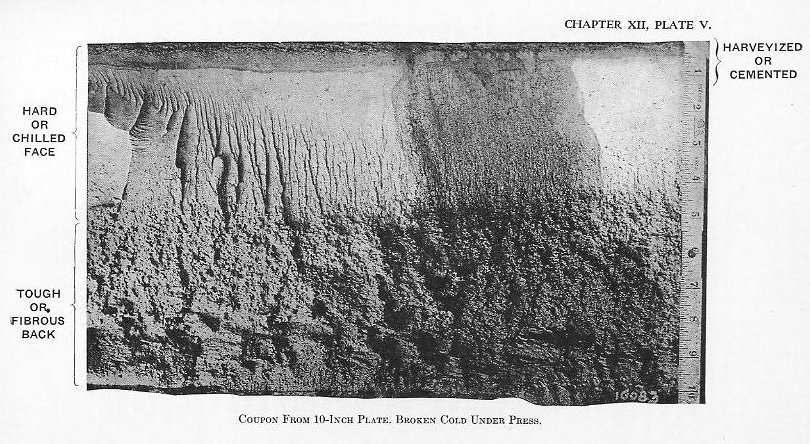
A section of a Krupp plate
Face-hardened armor remained in use from the mid-1890s onward, and all later armor is generally considered Krupp armor. However, continued improvements in metallurgy meant that the best WWII armors were as much as 40% more effective than the early Krupp plates.
Armor production was often a major limiting factor in battleship design. The equipment was expensive and specialized, and in many early ships the belt was set by the thickness of armor that could be produced. If thicker armor was needed, then multiple layers were used, which considerably reduced their effectiveness compared to a single plate.
Next time, I'll discuss the mechanics of armor penetration, which became increasingly important to the design of protection during the dreadnought era.
1 Armor under about 4” is often specified in terms of weight instead of thickness. 100 lbs = 2.5”. ⇑
2 Water is good at stopping shells, so underwater hits are unlikely, but hits near the waterline lead to flooding. ⇑
3 The term for the exhaust system of the boilers. ⇑
4 Some ships even had water-excluding material (usually cellulose) fitted to preserve buoyancy in these areas, although it was never very effective. ⇑
5 The Italians built a pair of ships, Italia and Lepanto, which had only a protective deck and tub barbettes, with no belt. The problem with this was that it provided insufficient protection to the ship's structure, and no other battleships were built in this manner. It was, however, a very common scheme for cruisers. Cruisers armored in this manner were called protected cruisers, as opposed to armored cruisers with belts. ⇑
6 One of the major constraints on warship design is topweight. If you have too much of it, the ship tips over. The various types of barbettes reduced the topweight required to put guns at a given height. ⇑
7 Most reference books disagree with this, but I give the full explanation for my thinking on the matter here. ⇑
8 As an example of how rapid armor development was in this era, the pre-dreadnoughts of the Russian Poltava class each had a different type of belt armor. Petropavlovsk had plain nickel steel, Sevastopol had Harvey armor, and Poltava had Krupp armor. ⇑
9 The face was also cemented in most Krupp armors, although by WWII some powers had stopped, as improvements in shell design had made it useless. ⇑

Comments
Nickel is not spelled nickle. You refer to QF guns early in the piece and later explain what QF is. Maybe the explanation needs to occur at the first reference?
That's one of the spelling errors I reliably make. To the point where I was pretty sure I'd corrected for it, but it looks like I had it right the first time. Thanks for catching it.
When you say that one armour is X% better than another, what does that mean? Weight of shell stopped, inches penetrated at given range, probability of stopping a hot?
It's in thickness equivalent. So a mild steel or compound plate 10" thick is going to stop/let through the same shell as a 12.5" wrought iron plate. It's not a perfect metric, because you start to see different ways of damaging a shell or the shell avoiding damage, but it's a good rule of thumb.
I don't believe the turret in the picture belongs to the Monitor. The monitor never had an conning tower on top of it's turret.
That is probably true, actually. I will relabel the photo.